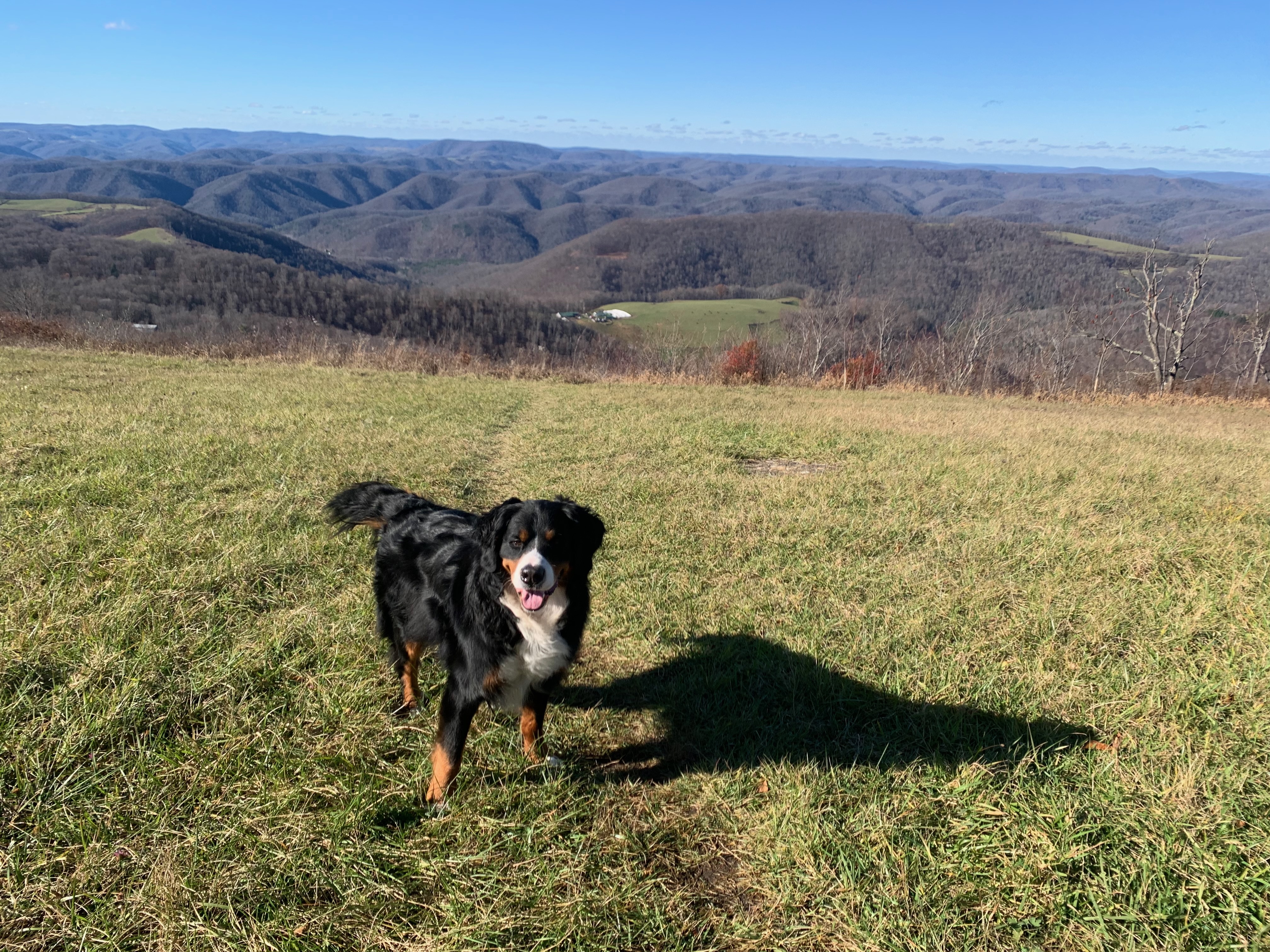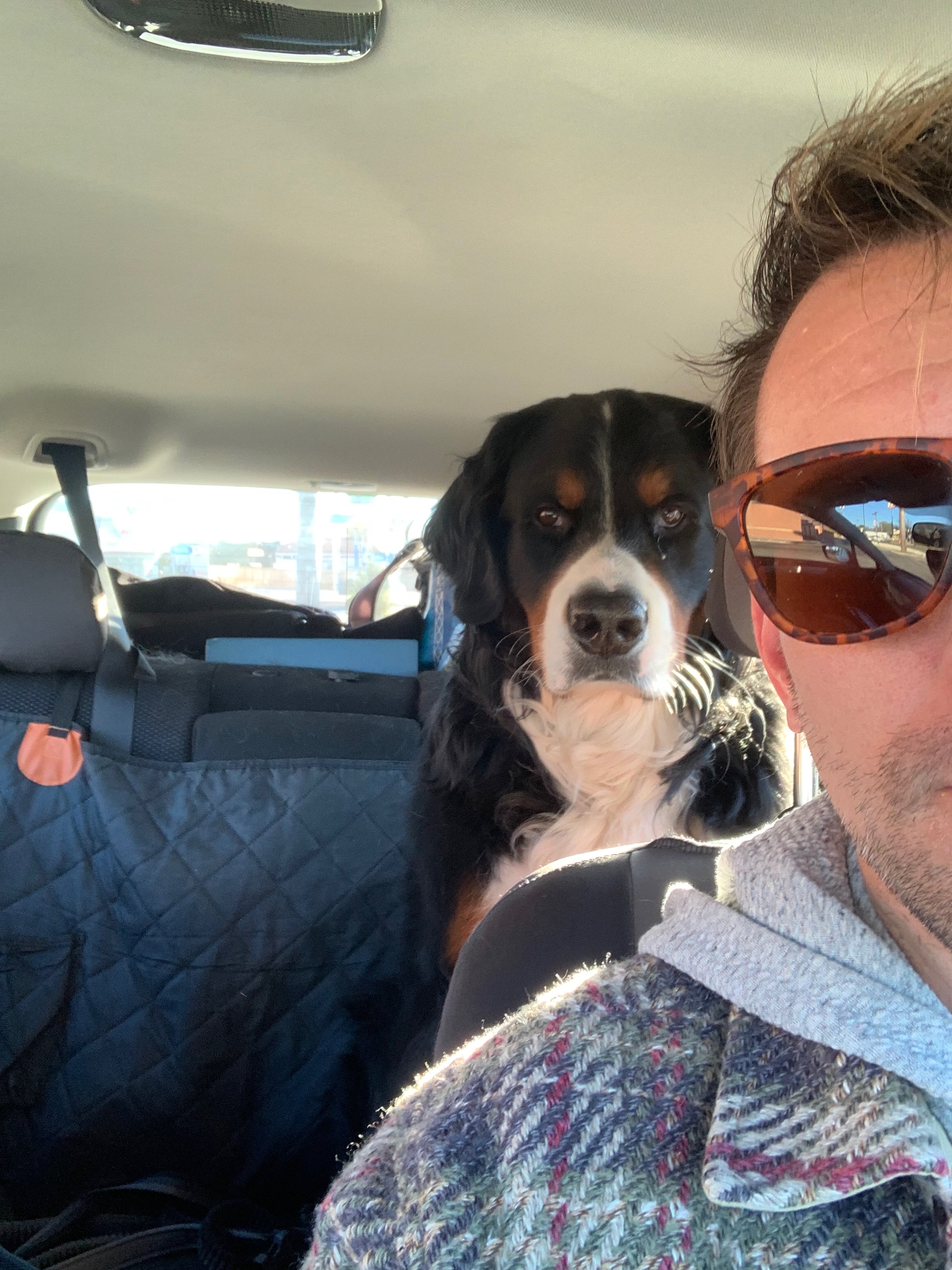
On the evening of the 2024 election, half the country was in mourning. The other half saw it as long-overdue vindication. Trump wasn’t just winning the presidency in a landslide—Republicans were poised to retake the Senate and House, too.
In Denver, where I watched the results roll in, the despair felt existential. A friend turned to me.
“You were in the military, right?”
I nodded.
“So you could train people to shoot guns?”
The conversation swerved—armed insurrection, expatriation. I was stunned.
By 9 p.m., I left, confused and shaken. These weren’t fringe ideologues. These were friends—rational people, committed citizens.
How did we get here? When did anarchy, rebellion, violence—mob behavior––become seemingly legitimate forms of protest?

Backbone Mountain, West Virginia. Photo by the author.
The conversation in Denver haunted me. I was suddenly awake to a fundamental shift—not just in politics, not just online, but in the way Americans saw each other in the day to day. I needed space to think.
So I drove.
In 2024, I logged 10,000 miles across America, both before and after the 2024 election. Fifteen states, countless highways, stretches of land often dismissed as “flyover country” but better described as “drive-through country”—places most often seen at 80 miles per hour, if they’re seen at all.
The trip was part impulse, part tradition. A friend had just completed his goal of visiting every U.S. county. Another had road-tripped through the South to study the history of American slavery. And I had my own memories of childhood road trips buried beneath decades of dust.
But mostly, I was chasing something distinctly American. Steinbeck did it. And maybe, I thought, I could find some clarity on the road too.
In Travels with Charley fashion I brought along my loyal companion, Bearheart, a five-year-old Bernese Mountain Dog. He lacks the intelligence to be navigator, or the ferocity to be protector, but he excelled in his most important role––conversation starter. Breakfast at a Waffle House in Amarillo, Texas, was a perfect example.
Before I went inside to feed myself, Bearheart waited, drooling by the car, watching as I dumped two cups of kibble into his bowl. He locked eyes with me, unmoving, until I gave the hand signal. Then he inhaled his food, trotted over to a grassy strip, performed his business, and reluctantly followed me back to wait in the car.
Inside, the Waffle House was in transition mode, the dead zone between the late-night drunks and the breakfast rush. Hozier’s "Too Sweet" played on the jukebox as a waitress wiped down the counter. She glanced at me.
“You’ve got a beautiful dog.”
“Thanks,” I said.
“Is it a Burmese Mountain Dog?”
It’s a common mix-up—Bearheart, a Bernese, has no connection to Myanmar—but I let it slide. “Saw them on a dog show the other day,” she added in a thick Texas drawl. “They was just trottin’ around.”
“That sounds right,” I said. “Not much for tricks. Just for looking at.”
Another waitress, Stephanie, further down the counter, chimed in. She had bright turquoise eyeliner and leaned heavily on a cane. “Sounds like me,” she said. “I don’t turn tricks no more, but I’m still damn good to look at.” She leaned into her cane with a slow body roll. The other women howled with laughter.
I laughed with them, absorbing their easy camaraderie, their ability to find humor in a 7 a.m. diner shift. We talked until they all went outside for a smoke break. I wondered who they voted for. Amarillo plumped >10 percentage points for Donald J. Trump and so my assumption would be that these ladies, if they voted at all, kept to that statistic. Liberals might look at them and think they’re voting against their interests, but it’s a condescending catchphrase that masks a host of complexities. I finished my meal, tipped generously, and hit the road––Bearheart was waiting and hundreds of miles remained back to Denver.
II.

Outside Waffle House on I-40 in Amarillo. Photo by the author.
III.
For all our divisions, America is still breathtakingly beautiful.
I drove at a time of year where I caught Autumn in nearly every place I visited. Southern Indiana along Interstate 64 was smoky and mist-drenched. I drove in silence, drinking in the surrounding countryside and its wet, loamy hills. Winter had not yet stripped leaves from the hardwoods, and yellows and reds and oranges popped in color, framed by evergreens as I whisked by.
This scene contrasted sharply with the red clay and dusty rock of Northern Texas and New Mexico. I stood atop Mt. Capulín, an extinct volcano named for the native chokecherry, and gazed northwest into Colorado at the Sangre de Cristo Range of the Rocky Mountains, 70 miles away, the bright phosphorescent blue triangles and snow-capped peaks easily distinguishable even at such a great distance. Eastward I looked into Texas, and north into the panhandle of Oklahoma. It was all plains and scrub trees, junipers, pinyon pines, and mesquite.
Windmills turned slowly beneath a washed-out sky, framing the cacti and scrub oak along Highway 83. A sign in big white letters on stone blocks outside Eden, Texas, encouraged me to return with a “Y’all Come Back”––the town itself only a small main street with western style brick storefronts, a public library, and a bright sign pointing you off the main drag to a new coffee shop. As I drove through the town—population 1,100—I wondered about the intentions of the founder, Frederick Ede, and what he wanted to accomplish, obviously having in mind that first society created by God. Did his Paradise meet expectations or did it amount to a similar level of disappointment?
I planned my route around places and people who shaped me—old friends, former Marines: Kansas City, where I attended an 11-piece Steely Dan tribute concert at The Ship with a college classmate; Charleston, West Virginia, where I had breakfast with an old friend, a retired professor of Shakespeare; Wilmington, North Carolina, to see the retirement ceremony for a close friend and Master Sergeant in the Marines; Laurel, Mississippi, to see another former Marine, now a husband and the father of two girls.
In Laurel I ate dinner at 320 Fifth Street, a bar and restaurant conveniently named for its address. Large colored Christmas lights hung on the walls. T-shirts of small local bands were plastered to the ceiling like tiles, bands with names like Ry Damn Davis, Champagne Jam, Witchcraft, and Merit Bade. The band currently on stage ran through a sound check while I ate dinner. I had been to enough of these small town shows in my youth to know that a really great band is one-in-a-million––their sound check left me convinced this wasn’t the one. I walked out and headed downtown before the show started at 8pm.
It was the Saturday before Thanksgiving but every streetlight was already adorned with garland and crowned with wreaths. The Magnolia State Bank building featured a brightly lit Christmas tree in every window on every floor. The Texas Postmaster BBQ next door was closed––moved to Hattiesburg. I wondered how many other businesses had done the same, seeing the college town as greener pastures.
In 2018, a friend recommended I read Our Towns by James and Deborah Fallows. Their trip, taken in their single engine prop airplane, was meant to visit the “flyover” territory of the United States, including cities across Mississippi and places like Charleston. In each town they talked to people who were revitalizing their local communities, unrusting the Rust Belt, filling in the hollowed husks of towns that had boomed in the post-WWII era. In Charleston, I walked the streets they wrote about; I went to the theaters and shops they described; and I came to very different conclusions. Despite their optimism, Charleston was not growing. In 1950 the population of Charleston was over 73,000. In 2008, it was 50,000. By the time I moved there in 2018—to lead a Reserve company of Marines—it was 48,000.
In 2024, nothing had changed.
I talked to a voter in his mid-twenties about the election. He was frustrated with Joe Manchin, despite the senator not even being on the ballot. He talked about alleged corruption between Joe Manchin and his daughter before telling me he voted for Trump and Patrick Morrisey, the new governor who promised to face down political elites. A gubernatorial candidate in 2008, Manchin once won nearly 70% of the vote in West Virginia. In 2024, his name alone was enough to provoke resentment—not because of any specific policy, but because of what he represented: a career politician, part of a political class they no longer trusted to see them. What academic and political elites—especially on the left—are talking about right now has little to do with the daily realities of small-town America: the gutted job markets, the empty storefronts, the quiet humiliation of being dismissed as backward—of being rural, blue-collar, or without a college degree in a country that increasingly defines success by mobility and credentials.
As I walked through Laurel, I thought of the Fallows’ book—one that brims with optimism but doesn't seem to match the reality of these small towns. Optimism comes easily when you’re there for 24 hours––what about 24 years? When the businesses all shutter and move down the road to Hattiesburg; when there’s not enough foot traffic to support the local coffee shop; when the young people choose college out of state because they know their career prospects are grim if they stay home; or when they skip college altogether and look for work elsewhere because there aren’t enough good jobs to go around. A study from the Chronicle of Higher Education finds that despite high school graduation rates in rural areas on par with urban areas, rural students are much less likely to go to college. Transportation costs and community obligations are two reasons, among many others, why rural students skip the undergraduate degree to remain home.
One thing I hear over and over again in my liberal circles is the refrain that people in places like Charleston, Laurel and Eden –– 49.8% of the country who voted for Donald Trump –– “voted against their interests”, a phrase made popular by Thomas Frank in his 2005 book What’s the Matter with Kansas? The catchphrase, used often by the left, is based on the Marxist idea of false consciousness: “the notion that people are so misled about reality that they act against their own interests”, as The Economist puts it. Most often it reveals a complete lack of identification with the people to whom it is applied––it substitutes condescension for comprehension.
Voters do know what they want. Immigration was a top concern in 2024—so they chose the candidate who promised action. Especially in rural America, voters feel more and more disconnected from the agendas and rhetoric of the political class. Trump, to borrow a phrase, makes them feel seen.
Scientific historian and philosopher Thomas Kuhn coined a phrase in his 1962 classic The Structure of Scientific Revolution to describe groups of scientists operating from different paradigms. The “incompleteness of logical contact” he diagnosed in scientific circles perfectly applies to politics. The rifts are stark: between left and right; between super rich and everyone else; between urban and rural. There is no more logical contact between these groups because they operate from fundamentally different paradigms, are brought up in different bubbles, and, increasingly, live in physically separated locations.
America's economic and cultural elite cluster in affluent urban enclaves, leaving rural and working-class communities increasingly isolated. A Brookings report emphasizes this fact––Trump won 2,633, or 86%, of the counties in the U.S. in 2024, but these counties represented only 36% of GDP. Harris’s meager 427 counties represented a whopping 62% of GDP, trends consistent with 2016 and 2024. That Democrats perform better in denser, richer, metropolitan urban cores is not new––but genuine lack of understanding for the other classes, demographics, and geographies demonstrated in our national discourse, our politics, and our conversations is.
In 2024 I spent only a few weeks visiting Other America. Robert Wuthnow, on the other hand, spent over a decade interviewing citizens in rural America––specifically communities of 25,000 and less. In The Left Behind: Decline and Rage in Rural America he summarizes his findings by modeling three communities: “Fairfield”––a midwestern town of 14,000; “Newborough”––a New England town of roughly 3,000; and “Gulfdale”––a small coastal community near the Gulf of…America. From thousands of interviews he distills the problems and themes across each: population decline, “brain drain”, teen pregnancy, drugs, lack of jobs, and cultural threats––all things on display in places like Eden, Laurel, and Charleston. The last one, cultural threats, tends to be where urban pundits focus when talking about rural America, leading to accusations of backwardness and even epithets like ‘deplorables’. As Wuthnow points out, media portrayals of rural areas tend to focus overwhelmingly on problems, reinforcing negative stereotypes and leading to further resentment from those who live there.
Taking direct aim at Thomas Frank’s “voting against their interest” thesis, Wuthnow argues that these small communities are best understood through relationships, obligations, and common understandings. Rather than economically self-interested individuals making decisions in silos, rural voters make decisions based on their view of their community, what the community values, and how they think they can affect it. He calls these ‘moral communities’; but not ‘moral’ as in ‘religious’ or ‘good, right, virtuous’; instead, he defines a moral community as one in which ‘people feel an obligation to one another and to uphold the local ways of being that govern their expectations about ordinary life’––a far cry from voting against their interests. Rather, it highlights a keen awareness of interest––albeit one at a communal rather than individual level.
This is also why the decline across these towns is so visceral: “Being part of a moral community,” writes Wuthnow, “even when it sits lightly on people’s shoulders, means that sensing your community is declining and your young people are falling behind is a reflection in small measure on you.”
Why does this matter?
Upwards of 40 million Americans live in rural areas. The number is much larger if we include areas considered “flyover” country, generally. And Wuthnow points out these people understand cities more than city dwellers understand them––the pervasive influence of media, especially the Internet, and frequent travel to places like New York City, Washington, D.C., and Los Angeles gives rural Americans a better understanding of their urban counterparts––but what Manhattanite takes time to visit, much less read about, Oklahoma?
What’s more these places remain a bastion of the American middle-class ideal. Writes Wuthnow, “The way of life they express isn’t far from what has always been considered the hallmarks of the American middle class . . . the norms they espouse pertain to a large share of the population . . ." Norms like knowing the people in your community, treating them with respect, rewarding hard work and praising personal responsibility. He goes on: "Being part of a community means caring about it enough to want it to be preserved. In these respects, rural communities are part of the culture of middle-class America that many observers say is currently threatened by policies that blatantly favor the rich at the expense of everyone else.”
The places James and Deborah Fallows visited in Our Towns; the cities I drove through on my trip; the areas represented by Wuthnow’s communities of Fairfield, Newborough and Gulfdale remain an important part of America––a part those of us in cities understand less and less.
This is the divide that shapes our political moment—not simply left vs. right, but urban vs. rural, “Fairfield” vs. urban centers. The election was never just about Trump, and the 2028 election won’t be either. There are deeper, more structural trends—making the dialogue exclusively about Donald Trump fails to address them. Expatriation won’t address them. Armed insurrection definitely doesn’t address them.

Bearheart, on his first roadtrip. Photo by the author.
IV.
I bought Bearheart from a “horse and buggy” Mennonite in Pennsylvania in 2019.
Bearheart, called “Jax” by the breeder, needed one final veterinarian appointment, but Mennonites don’t drive cars and his buggy wasn't hitched. So I offered him a ride––we spent the next four hours together and I asked lots of questions. I learned about the Mennonites relationship to technology, how they structure their communities, and what they value. On the seven hour ride back to West Virginia Bearheart sat quietly in the back seat––me, worriedly checking on him every 30 seconds––and I thought about what I had learned. I found myself admiring the Mennonites’ thoughtfulness in building communities and envying the emphasis on face-to-face interaction deliberately ingrained in their ways of working and living. Even when the buggy is hitched, you aren't going anywhere far, anywhere fast.
I’m no longer a resident of a rural area––and if you’re reading this you probably aren’t a resident of a town like Fairfield either—but I’m grateful to have grown up in Alabama and to have served in the Marine Corps, to have lived in places like West Virginia and North Carolina, and to keep connections with rural America. Yet I find it’s all too easy to lose that perspective of, comfort with, and sense of connection to these places. This is why I took this road trip, avoided interstates, ate in Waffle Houses, and stayed in cheap motels: to avoid the incompleteness of logical contact that plagues our elite classes. The miles on the road reinforced to me that physical contact precedes logical contact, something my horse-and-buggy Mennonite friend would see as obvious.
In the 1863 poem “Song of the Open Road” Walt Whitman encourages his reader to get out, to experience the United States, to visit the open roads, the harbors and the forests, the rivers and ‘the flagg’d walks of cities’, and then challenges us with this aside:
I and mine do not convince by arguments, similes, rhymes,
We convince by our presence.
That is the spirit we need.
And, Wuthnow points out, urbanites need it more than the truck drivers, the pipeline workers, and the small town cowboys:
“A first measure of understanding for those who live in cities and suburbs, I believe, is to step momentarily inside these communities before articulating disagreements––and certainly before denouncing millions of our fellow citizens as hopelessly deranged.”
It’s not the residents of Gulfdale who need to travel to a city––they already do that: for vacation, to see a son or daughter, or to visit the setting of their favorite TV show. Rather, the “elites” who live in these blue metro areas need to physically go to these rural areas, eat in the Waffle Houses, and meet the people. The first step toward circumventing our incompleteness of logical contact is through physical contact. “People don’t care how much you know,” said Theodore Roosevelt, “until they know how much you care.”
So go. Don’t dismiss—drive. Don’t assume—ask. If you want to understand, show up. If you want to change minds, listen. If you want to convince, then convince by your presence.

Jean-Luc Currie is co-editor of The Hart & The Cur.
We welcome Letters to the Editor. Send your thoughts, comments, and responses to jeanluc@thehartandthecur.com. We look forward to hearing from you.
Copyright © 2025 The Hart & The Cur

.jpg)

